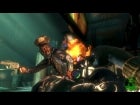I'm a sucker for Art Deco. Those who aren't amateur students of architecture or interior design may nonetheless be familiar with Art Deco's streamlined shapes, geometric designs and metallic structures from modern masterpieces like Radio City Music Hall or the design aesthetic of Batman: The Animated Series. In the 1930s it was perceived to be ultra-modern, progressive and forward-looking. It celebrated a future where rationality, science and industry would at last conquer the darkness and evil that haunts the human condition. In modern times, though, Art Deco is often used as a deliberately retro-future statement, the sad relic of a bright future that never happened. It is grimly appropriate, then, that BioShock''s ruined underwater utopia of Rapture is a decaying monument -- the last outpost of the lost world of Art Deco.
It was this week at E3 2007 that I finally got a chance to go hands-on with Irrational's BioShock. In between appointments I wandered into a Microsoft gaming lounge and sat down at an empty BioShock station. As the demonstrator fired up the game, text on the screen told me I was over the Atlantic and the year was 1960. Then there was darkness and I was surging through dark waters lit only by burning oil slicks on the surface. My plane had crashed and as I surfaced and avoided the fiery wreckage, I already knew I was in for something special. A few minutes more and I had navigated my way to a small lighthouse that contained a bathysphere that seemed to be my only hope for contacting someone and being rescued.
It was my trip down into the sea, though, that gave me my first glimpse into the amazing story of Rapture. As the bathysphere descended into the inky depths, a screen rose from the floor and an old fashioned black-and-white welcome film told me where I was headed. "Does a man not deserve to keep the sweat of his brow?" the voice of Andrew Ryan asked. "The U.S. government says it belongs to the poor, the Vatican says it belongs to God and the Communists say it belongs to everyone." Rapture, according to Ryan's message, is the place where anyone may prosper free of interference or censorship. It's a perfect world free of the corrupt influence of the weak. It's a seductive message from a radical thinker who had the fortitude to turn that dream into reality.
Indeed, it's after the film ends that I get my first glimpse of the reality, and it's everything he promised it to be. Rapture is magnificent -- there's just no other word to describe it. As my submersible heads through the city, I travel through the man-made underwater canyons formed by ornately decorated Art Deco buildings. Fish, squid and a blue whale swim by neon advertisements offering fine tobaccos, high fashion for the modern woman and something called "Plasmids." My trip through the exterior of this city fills me with awe at the grandeur of Ryan's vision. Then the bathysphere docks and I get a close look at the nightmare formed when such a dream goes sour.





